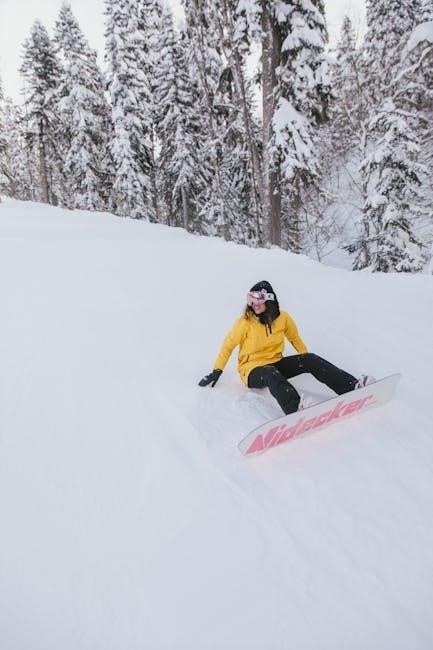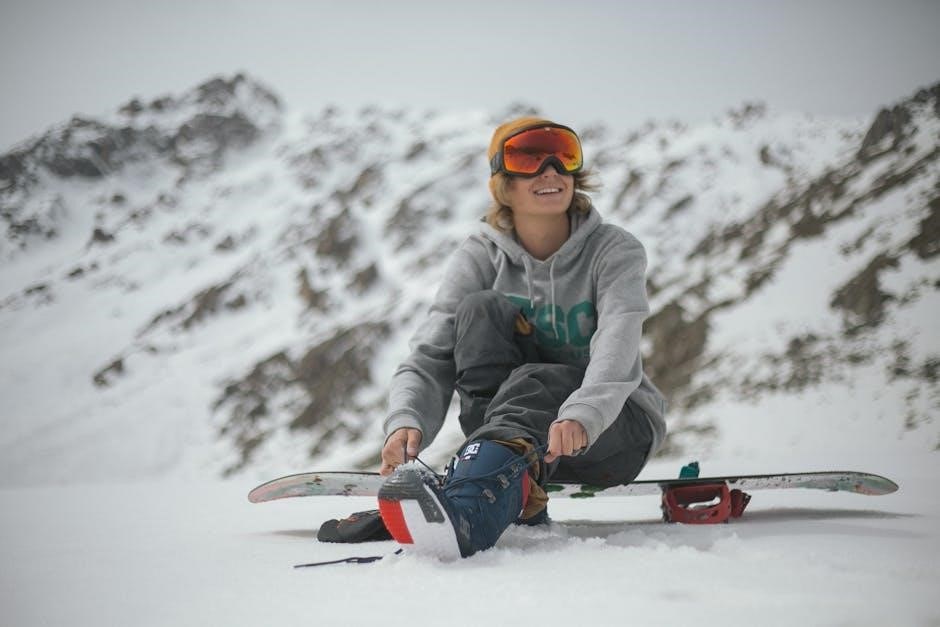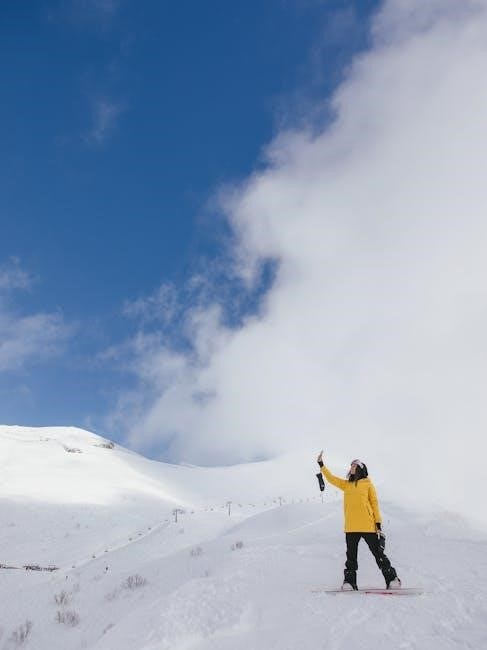Proper snowboard sizing is crucial for optimizing performance and comfort. This guide helps women choose the right size by considering height, weight, riding style, and boot fit.
1.1 Importance of Proper Snowboard Sizing
Proper snowboard sizing is essential for optimal performance, control, and safety on the slopes. A board that is too long or too short can hinder turning, stopping, and overall maneuverability. Incorrect sizing may lead to reduced stability, making it harder to balance, especially for beginners. Additionally, a poorly fitted board can cause fatigue and discomfort during extended rides. Ensuring the right size enhances responsiveness and confidence, allowing riders to fully enjoy their snowboarding experience. This guide helps women make informed decisions based on their height, weight, and riding style to find the perfect fit.
1.2 Overview of Sizing Factors
When selecting a women’s snowboard, several factors come into play, including height, weight, boot size, riding style, and ability level. These elements interconnect to determine the ideal board size and shape. Height and weight are primary considerations for length, while boot size influences width to prevent drag. Riding style, whether all-mountain, freestyle, or powder, affects the board’s shape and flex. Ability level also plays a role, as beginners may prefer softer flex for ease of control, while advanced riders might opt for stiffer boards for responsiveness. Balancing these factors ensures a snowboard that matches individual needs for performance and comfort.
Choosing the Right Snowboard Length
Choosing the right snowboard length ensures optimal performance and control. Measure height as a starting point, then consider weight, riding style, and ability level for the best fit.
2.1 Measuring Height for Snowboard Length
Height is a key factor in determining snowboard length. Stand tall and measure from the floor to the top of your head. For women, boards typically range from 140cm to 160cm. Beginners often find boards reaching their chin to eyes ideal, while advanced riders may prefer slightly shorter or longer based on style. Taller women may need longer boards for stability, while shorter riders can opt for shorter lengths without sacrificing performance. Always consider weight and riding style alongside height for the perfect fit.
2.2 Weight Distribution and Length
Weight distribution plays a significant role in determining the ideal snowboard length. Lighter riders may find shorter boards more maneuverable, while heavier riders benefit from longer boards for better floatation and control. Generally, riders under 120 lbs (54 kg) may prefer boards around 140-145cm, while those over 150 lbs (68 kg) may need boards closer to 152-160cm. Proper weight distribution ensures stability and responsiveness, allowing for optimal performance across various snow conditions. Balancing weight with length is crucial for achieving the right balance between ease of handling and overall board performance.
2.3 Riding Style and Length Considerations
Riding style significantly influences the ideal snowboard length. Freestyle riders often prefer shorter boards (140-148cm) for easier maneuverability and trick execution. All-mountain riders may opt for medium-length boards (145-155cm) to balance agility and stability. Powder riders benefit from longer boards (152-160cm) for better floatation in deep snow. Directional boards, ideal for speed and control, are typically longer; Riders should consider their primary style to ensure the board length aligns with their performance needs, enhancing responsiveness and overall riding experience. Proper length selection tailored to riding style ensures optimal performance across various terrains and conditions.
2.4 Ability Level and Length Recommendations
Snowboard length recommendations vary by ability level. Beginners benefit from shorter boards (140-148cm) for easier control and maneuverability. Intermediate riders often prefer medium-length boards (145-155cm) to balance stability and responsiveness. Advanced riders may opt for longer boards (152-160cm) for higher speeds and better edge hold. Riders progressing in skill should consider a slightly longer board to accommodate improving techniques. Proper length selection based on ability ensures a more enjoyable and efficient riding experience, allowing riders to focus on skill development and exploring various terrains with confidence.

Understanding Snowboard Width
Snowboard width is crucial for stability and control, with proper fit ensuring boots don’t hang over edges. Wider boards accommodate larger boot sizes, enhancing performance and comfort.
3.1 Boot Size and Snowboard Width
Boot size directly impacts snowboard width, as larger boots require wider boards to prevent toes from dragging in the snow. Proper fit ensures optimal performance and stability. If boots hang over the edges, it can lead to poor edge control and increased risk of catching an edge. Women should match their boot size to the board’s waist width, typically between 240-260mm for average boot sizes. Narrow or wide boards are available to accommodate smaller or larger boots, respectively. Ensuring a balanced fit enhances carving, turning, and overall riding comfort, making it a critical factor in selecting the right snowboard.
3.2 Width Charts for Women’s Snowboards
Width charts for women’s snowboards are essential for ensuring proper fit and performance. Typically, waist widths range from 240mm to 260mm, corresponding to average boot sizes. Proper alignment is crucial, as incorrect widths can affect control and comfort. Charts may vary slightly by brand, so consulting specific guidelines is recommended. Matching boot size to board width ensures efficient edge-to-edge movement and enhances the riding experience. Consider personal preference and riding style when choosing the ideal width for optimal comfort and performance on the slopes.

Snowboard Shape and Its Impact
Snowboard shape significantly influences performance, with directional, true twin, and hybrid options. Each shape offers unique benefits, such as better control, maneuverability, or float in powder conditions.
4.1 Directional Shape Characteristics
A directional snowboard features a longer nose than tail, enhancing float in powder and stability at high speeds. Its shape excels in all-mountain and powder conditions, offering precise control and smooth turns. The directional design allows for better edge hold and responsiveness, making it ideal for intermediate to advanced riders who prioritize performance in varied terrains. This shape is perfect for those seeking a board that balances power and maneuverability, ensuring a superior riding experience across different snow conditions.
4.2 True Twin Shape Benefits
The True Twin shape offers exceptional symmetry, making it ideal for freestyle and all-mountain riding. Its balanced design allows for effortless switch riding and enhanced pop, perfect for tricks and versatility. This shape ensures consistent edge hold in both directions, providing stability and control. True Twin boards are lightweight and lively, making them suitable for riders of all levels. Their versatility excels in various conditions, from park laps to exploring backcountry, offering a blend of performance and playfulness that caters to both intermediate and advanced riders seeking a fun, responsive experience on the mountain.
4.3 Hybrid Shape Features
The hybrid shape combines elements of directional and twin snowboards, offering versatility for various riding styles. It often features a blend of rocker and camber profiles, providing both float in powder and edge hold on groomed runs. Hybrid shapes are ideal for all-mountain riders who want adaptability. They deliver a balanced feel, making them suitable for exploring different terrains. This shape is perfect for women seeking a board that can handle both carving on hardpack and navigating through fresh snow with ease, making it a practical choice for those who enjoy a mix of conditions and riding styles.
Flex and Its Importance
Flex determines a snowboard’s responsiveness and maneuverability. Softer flex suits beginners and freestyle, while stiffer boards excel for speed and control, impacting overall riding performance significantly.
5.1 Soft Flex Snowboards
Soft flex snowboards are ideal for beginners and freestyle riders, offering a forgiving ride. They are lightweight and flexible, making turns easier to initiate and control at slower speeds. This flex is perfect for lighter riders or those with a more relaxed style. Soft flex boards are also great for buttering and jibbing, as they allow for playful manipulation. Riders progressing their skills will appreciate the ease of use, while experienced shredders can enjoy the creative freedom. Soft flex is a key feature for women seeking a board that matches their energy and riding preferences, ensuring a smooth and enjoyable experience on the mountain.
5.2 Medium Flex Snowboards
Medium flex snowboards offer a balanced ride, combining forgiveness with responsiveness. They are versatile, catering to a wide range of riders, from intermediate to advanced. This flex is ideal for all-mountain riding, providing stability at higher speeds while maintaining playfulness for exploring various terrains. Medium flex boards are suitable for women who seek adaptability, allowing them to transition smoothly between carving groomers, navigating trees, and tackling bumps. They strike a perfect balance between soft and stiff, making them a popular choice for riders who enjoy a mix of precision and ease; Medium flex is a reliable option for everyday shredding, ensuring consistent performance across different conditions.
5.3 Stiff Flex Snowboards
Stiff flex snowboards are designed for advanced to expert riders seeking high-performance responsiveness. They excel at high speeds, delivering precise control and edge hold, making them ideal for carving, freeride, and challenging terrain. Stiff boards provide exceptional stability and power, allowing riders to tackle demanding conditions with confidence. However, they are less forgiving, requiring skilled technique to handle effectively. Stiff flex is perfect for women who prioritize performance and are comfortable with a more aggressive riding style. These boards are built for those who demand the best in speed and precision, offering unparalleled responsiveness for experienced shredders.
Boot Size and Fit
Proper boot fit is essential for comfort and performance. Ensure boots match your foot size, providing adequate support and flexibility. Ill-fitting boots can hinder control and cause discomfort.
6.1 How to Size Snowboard Boots
When sizing snowboard boots, try them on with the same socks you’ll wear riding. Ensure a snug fit, with toes lightly touching the front and heels secure. Measure foot length and compare to brand size charts, as sizing varies. Check width to avoid pressure points. Flex should match your riding style—softer for beginners, stiffer for advanced riders. Proper fit balances comfort and responsiveness, ensuring optimal control and performance on the mountain. Pay attention to lacing systems and liner fit for added support and customization.
6.2 Ensuring Proper Boot Fit
Proper boot fit is essential for comfort and performance. Stand up with the boots laced tightly to assess fit. Your toes should lightly touch the front, with no pressure points. Ensure the heel stays secure to prevent lift while flexing. Check for snugness around the midfoot and ankle without constriction. Walk and move to verify mobility and support. Boots that are too tight or too loose can cause discomfort or hinder control. Proper fit ensures responsiveness, warmth, and all-day riding comfort. A well-fitted boot enhances overall snowboarding experience and prevents fatigue or injury.

Ability Level and Snowboard Choice
Snowboard choice varies by ability level, with beginners needing forgiving boards, intermediates seeking balanced performance, and advanced riders opting for specialized designs tailored to their expertise.
7.1 Snowboards for Beginners
Beginners should opt for snowboards that are forgiving and easy to maneuver. A board length between 140cm to 152cm is ideal, reaching chin to eye level when stood vertically. Softer flex ratings provide better control, making it easier to learn turns and balance. Width should match boot size for optimal performance. Directional or true twin shapes are recommended for stability and ease of turning. These features help build confidence and skill progression. Ensure proper fit by consulting size charts and considering weight distribution. The right beginner board will enhance the learning experience and make snowboarding enjoyable from day one.
7.2 Intermediate Rider Options
Intermediate riders benefit from snowboards with balanced performance and versatility. A medium flex rating offers stability and responsiveness, ideal for progressing skills. Lengths between 146cm to 154cm suit most riders, while width should align with boot size for optimal control. All-mountain or hybrid shapes are excellent choices, providing adaptability across various terrains. Ensure the board supports your weight and riding style for consistent performance. Proper fit and balance are key to advancing your technique and exploring more challenging trails with confidence. Choose a board that matches your improving skills to enhance your overall snowboarding experience.
7.3 Advanced Snowboard Selection
Advanced riders require high-performance snowboards tailored to their precise needs. Stiffer flex ratings enhance edge control and responsiveness, ideal for challenging terrains. Length and width should be carefully matched to the rider’s height, weight, and boot size for optimal performance. Directional or true twin shapes are popular for advanced riders, offering superior stability and maneuverability. When selecting a snowboard, consider the specific riding style, such as freeride or freestyle, to ensure the board meets performance demands. Consulting detailed size charts and expert recommendations can help advanced riders find the perfect fit for their skill level and preferences.

Riding Style and Board Match
Riding style significantly influences snowboard choice, with all-mountain, freestyle, and powder boards offering unique features tailored to specific needs, ensuring optimal performance and enjoyment on the slopes.
8.1 All-Mountain Snowboarding
All-mountain snowboarding requires a versatile board that excels in various conditions, from groomed trails to backcountry terrain. Women opting for this style should choose a snowboard with a length between 144cm and 152cm, ensuring it matches their height and weight for optimal control. The width should provide ample stability while maintaining maneuverability. Boards designed for all-mountain riding often feature a directional shape, offering better edge hold and responsiveness. This style is ideal for riders who enjoy exploring diverse terrain and need a reliable, adaptable snowboard to handle it all effectively.
8.2 Freestyle Snowboarding
Freestyle snowboarding emphasizes tricks, jumps, and agility, requiring a shorter, more maneuverable board. Ideal lengths for women range from 138cm to 146cm, allowing for easier rotation and control in the air. A true twin shape is highly recommended, as it enables effortless switch riding and balanced landings. Softer flex ratings enhance flexibility for pressing and buttering tricks. Ensure the width matches your boot size to avoid drag and maintain precision. Freestyle boards are perfect for park riding and creative expression, making them a great choice for women who prioritize agility and playful performance.
8.3 Powder Snowboarding
Powder snowboarding requires a board designed for deep snow and floatation. Women should opt for longer lengths, typically between 152cm and 160cm, to enhance stability and control. A directional shape with a wider nose and tapered tail is ideal, as it improves buoyancy and reduces leg fatigue. Medium to stiff flex ratings provide the necessary response for navigating challenging terrain. Ensure the width accommodates your boot size to prevent drag. Special features like a rockered nose further boost performance in powder conditions, making these boards perfect for adventurous riders seeking thrilling experiences in untouched snow.
Popular Brands for Women
Top brands like Roxy, Burton, and Salomon offer high-quality women’s snowboards in various sizes and styles, ensuring a perfect fit and exceptional performance.
9.1 Top Brands Offering Women’s Sizes
Leading brands such as Roxy, Burton, and Salomon specialize in women’s snowboards, offering a wide range of sizes and styles. These brands prioritize female-specific designs, ensuring optimal performance and comfort. Roxy is known for its durable and stylish boards, while Burton provides versatile options for all skill levels. Salomon focuses on innovative technology for enhanced ride quality. Each brand offers detailed size charts, making it easier for women to find the perfect fit based on height, weight, and riding style. Checking the specific size guides for each brand is essential for the best match.
9.2 Brand-Specific Size Charts
Brand-specific size charts are essential for accurate snowboard sizing. Top brands like Burton, Roxy, and Salomon provide detailed charts tailored to women’s dimensions. These charts often include height, weight, and boot size ranges, ensuring a precise fit. For example, Burton offers a “True Fit” system, while Roxy focuses on female-specific proportions. Always check the brand’s official website for the most accurate and up-to-date sizing information. Using these charts helps women find a board that matches their body type and riding style perfectly, enhancing performance and comfort on the slopes.
Weight and Snowboard Size
Weight is a key factor in determining the ideal snowboard size. Heavier riders may require longer boards for better float and control, while lighter riders prefer shorter options.
10.1 Lightweight Riders
Lightweight riders, typically under 120 pounds, should consider shorter snowboards for better maneuverability and control. A board in the 138-146cm range is often ideal, providing easier handling and improved float in powder. Proper weight distribution ensures the board responds well to input, while shorter lengths reduce fatigue. Width should still match boot size to prevent toe drag and enhance performance. Lightweight riders may also benefit from softer flex patterns for easier turning. Balancing weight with height and riding style ensures the best fit, making every run more enjoyable and efficient on the slopes.
10.2 Average Weight Considerations
For average-weight riders (120-160 pounds), snowboard length should align with height and riding style. A board between 146-152cm is often ideal, offering stability and maneuverability. Proper weight distribution enhances edge control and float in various snow conditions. Ensure the board’s width matches boot size to prevent toe drag and improve performance. Average-weight riders typically prefer medium flex for balanced responsiveness. Consider how weight interacts with height and riding style to find the perfect fit, ensuring optimal performance and comfort on the mountain. This balance is key for an enjoyable and responsive snowboarding experience.
10.3 Heavyweight Options
Heavier riders (over 160 pounds) often benefit from longer snowboards for added stability and float. A board length of 153-160cm is typically recommended, depending on height and riding style. Wider boards may be necessary to accommodate larger boot sizes, ensuring proper toe and heel placement. Stiffer flex ratings are also advantageous for heavier riders, as they provide better edge control and responsiveness. Proper weight distribution is crucial for optimal performance in all snow conditions. Consulting a detailed size chart or seeking expert advice can help heavier riders find the perfect balance of length, width, and flex for their needs.

Height and Snowboard Fit
Height plays a key role in determining snowboard size, with shorter riders needing smaller boards and taller riders requiring longer ones for optimal performance and control.
11.1 Shorter Riders
For women with shorter stature, choosing the right snowboard size is essential for balance and control. A shorter snowboard, typically between 140cm to 148cm, is recommended to match their height. Riders under 5’2″ may find smaller boards easier to maneuver, while those closer to 5’4″ can opt for slightly longer options. Weight and riding style also influence the ideal length, with lighter riders potentially preferring shorter boards and heavier riders needing more stability. Proper boot fit is crucial to ensure comfort and performance, regardless of height. Testing the board’s feel is always advisable for the best fit.
11.2 Average Height Riders
For women of average height, typically between 5’4″ and 5’8″, the ideal snowboard length ranges from 148cm to 152cm. This size range provides optimal control and maneuverability. Lighter riders may prefer the shorter end of this spectrum, while heavier riders might opt for a slightly longer board for stability. Riding style also plays a role—freestyle riders might choose shorter boards for easier tricks, while all-mountain riders might prefer longer boards for better float. Proper boot fit is essential to ensure comfort and performance. Testing the board’s feel is always advisable for the best fit.
11.3 Tall Riders
Tall women, typically those 5’9″ or above, benefit from longer snowboards for better stability and control. Boards in the 153cm to 157cm range are ideal, providing float in powder and edge hold at higher speeds. Heavier riders may prefer stiffer flex for added responsiveness. Riding style also influences the choice—freeride and all-mountain riders often opt for longer lengths, while freestyle riders might prefer shorter boards for maneuverability. Proper boot fit and binding placement are crucial to maintain balance and comfort. Testing the board’s feel is highly recommended to ensure the best match for tall riders’ needs.
Choosing the right snowboard involves balancing height, weight, and riding style. This guide helps women make informed decisions, ensuring optimal performance and comfort on the slopes.
12.1 Final Tips for Choosing the Right Snowboard
When selecting a snowboard, prioritize your height, weight, and riding style to ensure the best fit. Double-check boot compatibility and refer to size charts for accuracy. Always test a board if possible, as feel and performance can vary. Consider reading reviews or consulting experts for additional insights. Remember, the right snowboard enhances control, comfort, and confidence, making every ride more enjoyable. Take your time and don’t hesitate to seek advice to find the perfect match for your needs and preferences.
12.2 Encouragement to Test and Adjust
Testing your snowboard before purchasing is highly recommended to ensure the best fit and performance. Many shops offer demo days or rental options, allowing you to experience different models. Don’t hesitate to adjust your setup as your skills improve or preferences change. Proper fit and feel are key to enjoying your time on the mountain. Remember, it’s okay to seek advice or try multiple options—investing time now ensures a better riding experience later. Confidence and comfort on the snowboard will enhance your overall enjoyment, so take the time to get it right.
